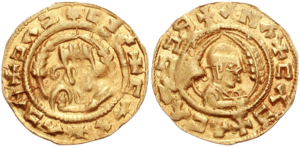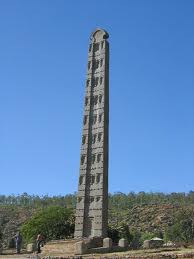One historian noted that there were four great powers of his time in the third century AD: China, Rome, Persia, and…Aksum. While almost everyone is familiar with the first three, the Kingdom of Aksum is not as well known. I’ll share a few facts about Aksum, and then ask you a question:
- Was a long-lasting empire: from 100 AD to 940 AD
- Grew wealthy due to being a major trading link between Rome and India
- Had its own written language called ‘Ge’ez’
- Had a distinctive architectural style, including making the largest known construction of this style
- Imported silver, gold, olive oil, and wine
- Exported luxury goods of glass crystal, brass, copper – and also frankincense and myrrh
- Had a ‘pyramid’ structure society with kings at the top, then lower status nobles, then farmers, and finally ordinary workers
- Had large palaces and funeral tombs
- Had a strong military with modern weapons and horses, and conquered nearby kingdoms
- Build and operated ships, and had their own navy
- Had a high literacy rate
- Accomplished in pottery making, ivory carving, glassware production, and metalwork.
- Issued their own gold coinage at a time when few other kingdoms in the world could do so
Now the question: which continent was Aksum on? If you don’t know, then take a guess before continuing…
I’ll count to ten to give you time…please do not scroll down until you’ve at least made a guess! 🙂
One…
Two…
Three…
Four…
Five…
Six…
Seven…
Eight…
Nine…
…and Ten!
The answer is…
…Africa.
Besides Egypt, for some reason schools around the world (at least outside of Africa) do not teach about some of the other great kingdoms of Africa, and we rarely hear about these in the materials we read, shows that we watch, and movies that we see. There were several great kingdoms in Africa, and Aksum was one of them. It was located primarily in the area that is now Ethiopia and Eritrea. It grew wealthy via trade through the Red Sea.
Some additional notes of interest about Aksum are:
- The architectural style referred to above is the ‘obelisk’. Hundreds of obelisks were constructed, including the Great Stele, which at 33 meters is said to be the largest known obelisk.
- They were the first native African kingdom to issue their own coins. Interestingly, their coins included writing in Greek due to their usage in the critical Greco-Roman trade of that time
- It is said to be the home of the Queen of Sheeba
- It is said to be the home of the Ark of the Convenant (contains the tablets with the original Ten Commandments of Moses), which is kept here protected by Coptic monks (the Ark was smuggled here by Menelek, the son of King Solomon and the Queen of Sheeba)
- The empire covered modern day Ethiopia, Eritrea, western Yemen, southern Saudi Arabia, northern Sudan, southern Egypt, and Djibouti – an area of 1.25 million square kilometers!
- In the fourth century AD, the emperor Ezana converted to Christianity, making Aksum the first known major empire to convert to Christianity and the first state in history to use the image of the cross on its coins.
- Aksum provided shelter to a group of Muslims in the seventh century AD fleeing persecution – this is known in Islamic history as the First Hijra.
- The architectural style referred to above is the ‘obelisk’. Hundreds of obelisks were constructed, including the Great Stele, which at 33 meters is said to be the largest known obelisk.
Aksum eventually declined for various reasons, including changing trade routes which no longer involved Aksum and severe environmental degradation.
Unfortunately often our understanding and views of a country like Ehtiopia are through some of the modern news that we’ve seen over the years concerning challenges facing the country and the people of Ethiopia. But Ethiopia also has a glorious past, which includes the amazing kingdom of Aksum.




